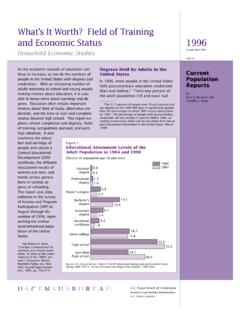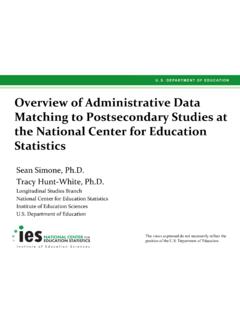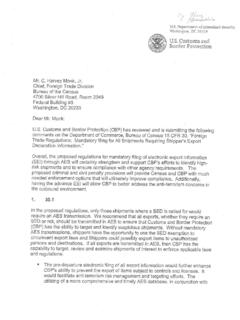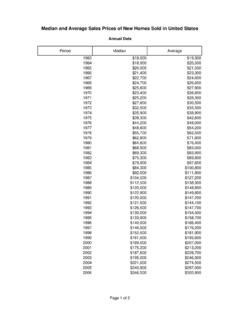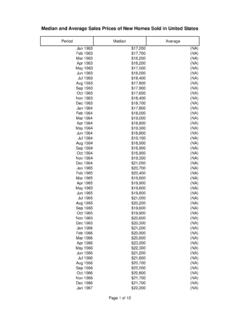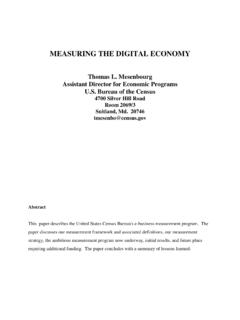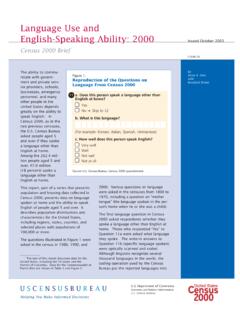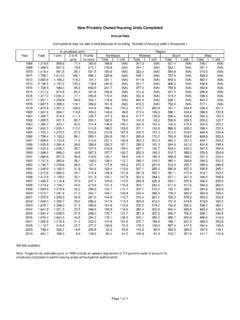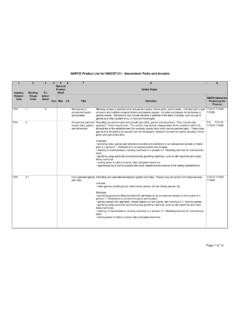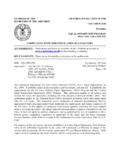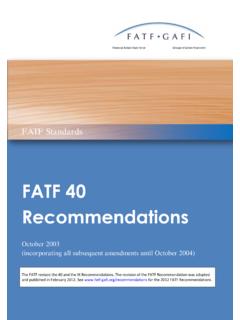Transcription of The Black Population: 2010
1 Department of Commerce Economics and Statistics Administration CENSUS BUREAU The Black population : 20102010 Census BriefsBy Sonya Rastogi, Tallese D. Johnson, Elizabeth M. Hoeffel, and Malcolm P. Drewery, Jr. C2010BR-06 Issued September 2011 INTRODUCTIONThis report provides a portrait of the Black population in the United States and discusses its distribu-tion at the national level and at lower levels of , 2 It is part of a series that analyzes pop-ulation and housing data collected from the 2010 Census. The data for this report are based on the 2010 Census Redistricting Data (Public Law 94-171) Summary File, which was the first 2010 Census data product released with data on race and Hispanic origin and was provided to each state for use in drawing boundaries for legislative RACE DATA FROM THE 2010 CENSUSThe 2010 Census used established federal standards to collect and present data on the 2010 Census, the question on race was asked of individuals living in the United States (see Figure 1).
2 An individ-ual s response to the race question was based upon self-identification. The Census Bureau collects information on race following the guidance of the Office of Management and Budget s 1 The terms Black and Black or African American are used interchangeably in this This report discusses data for the 50 states and the District of Columbia, but not Puerto Rico. 3 Information on the 2010 Census Redistricting Data (Public Law 94-171) Summary File is available online at < >.(OMB) 1997 Revisions to the Standards for the Classification of Federal Data on Race and These federal stan-dards mandate that race and Hispanic origin (ethnicity) are separate and distinct concepts and that when collecting these data via self-identification, two different questions must be The 1997 Revisions to the Standards for the Classification of Federal Data on Race and Ethnicity, issued by OMB, is available at < /omb/ >.5 The OMB requires federal agencies to use a minimum of two ethnicities: Hispanic or Latino and Not Hispanic or Latino.
3 Hispanic origin can be viewed as the heritage, nationality group, lineage, or country of birth of the person or the person s parents or ancestors before their arrival in the United States. People who identify their origin as Hispanic, Latino, or Spanish may be of any race. Hispanic or Latino refers to a person of Cuban, Mexican, Puerto Rican, South or Central American, or other Spanish culture or origin regardless of race. Figure of the Question on Race From the 2010 CensusSource: Census Bureau, 2010 Census Census BureauStarting in 1997, OMB required federal agencies to use a minimum of five race categories: White, Black or African American, American Indian or Alaska Native, Asian, and Native Hawaiian or Other Pacific Islander. For respondents unable to identify with any of these five race categories, OMB approved the Census Bureau s inclusion of a sixth category Some Other Race on the Census 2000 and 2010 Census questionnaires.
4 The 1997 OMB standards also allowed for respon-dents to identify with more than one race. The definition of the Black or African American racial category used in the 2010 Census is presented in the text box on this page. Data on race have been collected since the first decennial census in For the first time in Census 2000, individuals were presented with the option to self-identify with more than one race and this continued with the 2010 Census, as prescribed by OMB. There are 57 possible mul-tiple race combinations involving the five OMB race categories and Some Other 2010 Census question on race included 15 separate response categories and three areas where respondents could write in detailed information about their race (see 6 For information about comparability of 2010 Census data on race and Hispanic origin to data collected in previous censuses, see the 2010 Census Redistricting Data (Public Law 94-171) Summary File Technical Documentation at < /cen2010/ >.)
5 7 The 2010 Census provides data on the total population reporting more than one race, as well as detailed race combina-tions ( , Black or African American and White; Black or African American and Asian and American Indian and Alaska Native). In this report, the multiple-race categories are denoted with the conjunction and in bold and italicized print to indicate the separate race groups that comprise the particular 1).8 The response catego-ries and write-in answers can be combined to create the five mini-mum OMB race categories plus Some Other Race. In addition to White, Black or African American, American Indian and Alaska Native, and Some Other Race, 7 of the 15 response categories are Asian groups and 4 are Native Hawaiian and Other Pacific Islander a complete explanation of the race categories used in the 2010 Census, see the 2010 Census Brief, Overview of Race and Hispanic Origin: There were two changes to the question on race for the 2010 Census.
6 First, the word-ing of the race question was changed from What is this person s race? Mark one or more races to indicate what this person con-siders himself/herself to be in 2000 to What is this person s race? Mark one or more boxes for 2010 . Second, in 2010 , examples were added to the Other Asian response category (Hmong, Laotian, Thai, Pakistani, Cambodian, and so on) and the Other Pacific Islander response category (Fijian, Tongan, and so on). In 2000, no examples were given in the race The race categories included in the census questionnaire generally reflect a social definition of race recognized in this country and are not an attempt to define race biologi-cally, anthropologically, or genetically. In addi-tion, it is recognized that the categories of the race question include race and national origin or sociocultural Humes, K., N. Jones, and R. Ramirez. 2011. Overview of Race and Hispanic Origin: 2010 , Census Bureau, 2010 Census Briefs, C2010BR-02, available at < >.
7 RACE ALONE, RACE IN COMBINATION, AND RACE ALONE-OR-IN-COMBINATION CONCEPTSThis report presents data for the Black population and focuses on results for three major conceptual groups. People who responded to the ques-tion on race by indicating only one race are referred to as the race alone population , or the group who reported only one race. For example, respondents who marked only the Black , African Am., or Negro category on the census questionnaire would be included in the Black alone population . This population can be viewed as the minimum number of people report-ing who chose more than one of the six race categories are referred to as the race in combina-tion population , or as the group who reported more than one race. For example, respondents who reported they were Black or African American and White or Black or African American and Asian and American Indian and Alaska Native would be included in the Black in combination population .
8 This population is also referred to as the multiple-race Black OF Black OR AFRICAN AMERICAN USED IN THE 2010 CENSUSA ccording to OMB, Black or African American refers to a person having origins in any of the Black racial groups of Black racial category includes people who marked the Black , African Am., or Negro checkbox. It also includes respondents who reported entries such as African American; Sub-Saharan African entries, such as Kenyan and Nigerian; and Afro-Caribbean entries, such as Haitian and Jamaican.**Sub-Saharan African entries are classified as Black or African American with the excep-tion of Sudanese and Cape Verdean because of their complex, historical heritage. North African entries are classified as White, as OMB defines White as a person having origins in any of the original peoples of Europe, the Middle East, or North Census Bureau 3 The maximum number of people reporting Black is reflected in the Black alone-or-in-combination popu-lation.
9 One way to define the Black population is to combine those respondents who reported Black alone with those who reported Black in combination with one or more other races. This creates the Black alone-or-in-combination popu-lation. Another way to think of the Black alone-or-in-combination popu-lation is the total number of people who reported Black , whether or not they reported any other the report, the dis-cussion of the Black population compares results for each of these groups and highlights the diversity within the entire Black As a matter of policy, the Census Bureau does not advocate the use of the alone population over the alone-or-in-combination population or vice versa. The use of the alone population in sections of this report does not imply that it is a preferred method of pre-senting or analyzing data. The same is true for sections of this report that focus on the alone-or-in-combination population . Data on race from the 2010 Census can be presented and discussed in a variety of Black population : A SNAPSHOTThe 2010 Census showed that the United States population on April 1, 2010 , was million.
10 Out of the total population , million people, or 13 percent, identified as Black alone (see Table 1).12, 13 In addition, million people, or 1 percent, reported Black in combina-tion with one or more other races. Together, these two groups totaled million people. Thus, 14 percent of all people in the United States identified as Black , either 12 Percentages shown in text generally are rounded to the nearest integer, while those shown in tables and figures are shown with decimals. All rounding is based on unrounded calculations. Thus, due to rounding, some percentages shown in tables and figures ending in 5 may round either up or down. For example, unrounded numbers of and would both be shown as in a table, but would be cited in the text as 14 and 15, For the purposes of this report, the terms reported, identified, and classi-fied are used interchangeably to refer to the response provided by respondents as well as responses assigned during the editing and imputation , or in combination with one or more other Black population increased at a faster rate than the total total population grew by percent, from million in 2000 to million in 2010 (see Table 1).
